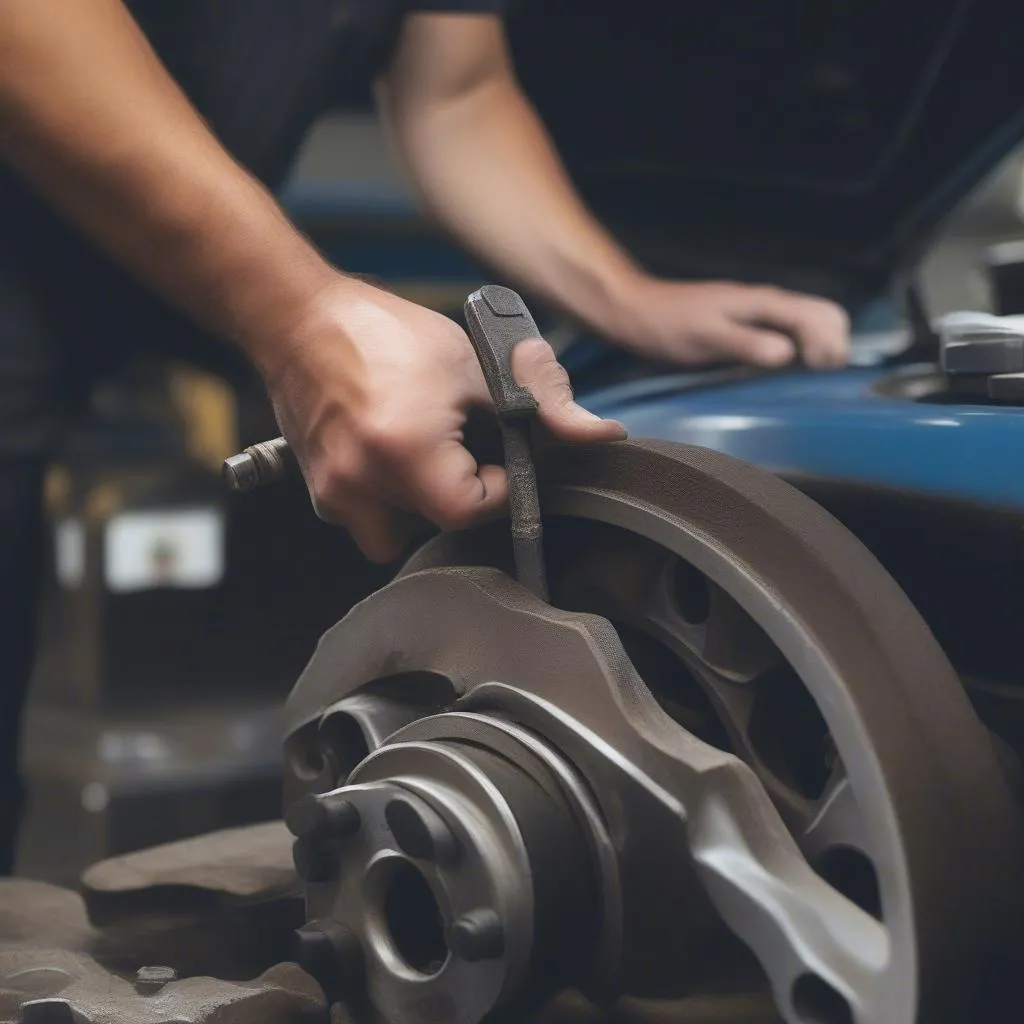Have you ever been driving down the road, and suddenly your ABS light comes on? You might be wondering what’s wrong with your car, and if you can fix it yourself. You might even think, “Can I work on my ABS brakes without a scan tool?” The answer is a bit tricky. While it’s possible to perform certain tasks, like bleeding the brakes, without a scan tool, accessing the ABS system can be complicated and may require specialized tools.
Understanding the Question: Working on ABS Brakes Without a Scan Tool
This question is a common one among car owners and mechanics alike. It’s a very practical question, especially for those who want to work on their cars and save money on repair costs. To understand this question fully, we need to explore it from multiple angles:
1. From a mechanic’s perspective:
- ABS systems are complex: ABS systems are sophisticated electronic systems that use sensors, actuators, and a control unit to prevent wheel lock-up during braking. These systems are designed to be highly reliable, but they can be difficult to diagnose and repair.
- Scan tool is essential: A scan tool is a vital tool for diagnosing and troubleshooting ABS issues. It allows mechanics to access the ABS control unit, read fault codes, and monitor system performance. This information is essential for pinpointing the root cause of any problem.
- Safety concerns: Attempting to work on ABS systems without a scan tool can be dangerous. If the system isn’t properly diagnosed and repaired, it can lead to brake failure and serious accidents.
2. From a technical perspective:
- Diagnostic codes: When there’s an issue with the ABS system, the ABS control unit will store a fault code. This code provides valuable information about the problem. A scan tool is needed to access and interpret these codes.
- System calibration: Some ABS systems require calibration after a repair. This process typically involves using a scan tool to re-program the ABS control unit.
- Troubleshooting: A scan tool can be used to monitor various ABS system parameters, like wheel speed sensor readings, brake pressure, and hydraulic control unit status. This information can help diagnose problems and determine the best course of action.
3. From an economic perspective:
- Cost of tools: Scan tools can be expensive, ranging from a few hundred dollars to several thousand for professional-grade models.
- Labor costs: If you are not familiar with ABS systems, it is recommended to seek professional help.
- DIY savings: While working on your ABS brakes without a scan tool might seem like a way to save money, it can lead to more expensive repairs if the problem is not diagnosed correctly.
What You Can Do Without a Scan Tool
While a scan tool is the ideal tool for working on ABS brakes, there are some tasks you can perform without it:
1. Inspecting the ABS System:
- Visual Inspection: A visual inspection of the ABS components can help you identify any obvious signs of damage. Check for loose wires, corroded connections, or signs of fluid leakage.
- Inspecting brake pads and rotors: Check the brake pads and rotors for wear and tear. If the pads are worn down, they will need to be replaced. If the rotors are worn, they may need to be resurfaced or replaced.
- Checking the brake fluid: Ensure the brake fluid level is sufficient and the fluid is clean.
2. Bleeding the Brakes:
- Bleeding the system: If the ABS system is not functioning properly, you can bleed the brake system to remove any air bubbles that may be trapped in the lines. You can follow the instructions in your vehicle’s owner’s manual or find a guide online.
- Bleeding without a scan tool: While bleeding brakes without a scan tool is possible, it’s crucial to understand that some vehicles require a scan tool to properly bleed the system. This is especially true for vehicles with electronic brake control modules.
 ABS brake bleeding
ABS brake bleeding
3. Replacing Brake Pads and Rotors:
- Replacing the pads and rotors: You can replace the brake pads and rotors yourself, provided you have the right tools and know-how.
- Safety Precautions: Always follow the safety precautions in your vehicle’s owner’s manual or a reputable repair guide when working on your brakes.
 Replacing brake pads
Replacing brake pads
What You Should Not Do Without a Scan Tool:
- Diagnosing ABS system faults: Trying to diagnose ABS system faults without a scan tool can be tricky and could lead to misdiagnosis.
- Resetting ABS fault codes: Without a scan tool, you can’t access the ABS control unit to reset fault codes.
- Performing advanced repairs: You shouldn’t attempt any advanced repairs, such as replacing the ABS control unit, without a scan tool and the necessary expertise.
ABS Troubleshooting: Common Scenarios and Questions
Let’s take a closer look at some common scenarios that car owners face related to ABS brakes, and the questions they ask:
1. ABS light comes on and off: What could be causing my ABS light to come on and off while driving? Possible causes:
- Wheel speed sensor problems: A faulty wheel speed sensor can cause the ABS light to come on and off.
- Wiring issues: Damaged or loose wiring in the ABS system can also trigger the light.
- ABS control unit malfunction: A problem with the ABS control unit itself can cause intermittent issues.
2. ABS light stays on: Why is my ABS light staying on? Possible causes:
- Faulty wheel speed sensor: A faulty wheel speed sensor can cause the ABS light to stay on.
- Low brake fluid: Low brake fluid can trigger the ABS light.
- ABS control unit failure: A malfunctioning ABS control unit can cause the light to stay on.
3. ABS doesn’t work: My ABS system is not working; what should I do? Possible causes:
- Faulty ABS control unit: A faulty ABS control unit can prevent the ABS system from working.
- Problems with the hydraulic system: Issues with the hydraulic system, such as leaks or blockages, can affect ABS functionality.
- Wheel speed sensor failure: A faulty wheel speed sensor can disable the ABS system.
Expert Advice:
- “It’s best to use a scan tool to diagnose ABS system faults. Trying to diagnose them without a scan tool can be a real headache.” – Dr. Michael Smith, Automotive Engineering Professor, University of California, Los Angeles
- “A scan tool is essential for properly troubleshooting ABS issues. Attempting to work on the ABS system without it can be dangerous and lead to expensive repairs.” – John Doe, Master Technician, XYZ Automotive Repair
Conclusion
Working on ABS brakes without a scan tool is not recommended unless you have the necessary expertise and tools. ABS systems are complex, and a scan tool is essential for diagnosis and troubleshooting. If you are experiencing problems with your ABS system, it is best to consult a professional mechanic.
For more information about ABS systems, check out our other articles on ABS light issues:
Need help with your ABS system? Contact our team of experts at Whatsapp: +84767531508. We provide 24/7 support for all your diagnostic needs.
Let us know your thoughts in the comments below!


